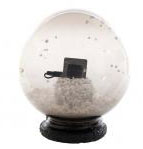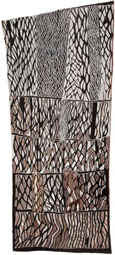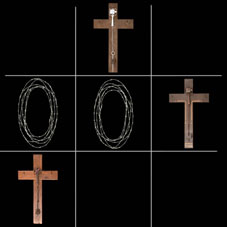 In last week’s post on the Salon des Refusés, I congratulated Matt Ward and Paul Johnstone for bringing back to Darwin’s awards season the sense of adventure and surprise that I used to receive regularly from the National Aboriginal and Torres Strait Islander Art Awards a decade or more ago. The kind of experience that I’d felt lacking in recent years.
In last week’s post on the Salon des Refusés, I congratulated Matt Ward and Paul Johnstone for bringing back to Darwin’s awards season the sense of adventure and surprise that I used to receive regularly from the National Aboriginal and Torres Strait Islander Art Awards a decade or more ago. The kind of experience that I’d felt lacking in recent years.
Nicolas Rothwell didn’t even wait this year for the show to open to pour out his dissatisfaction. Hours before the award winners were announced and MAGNT’s halls were opened to the annual tide of visitors, he bemoaned the corrosion of vitality that characterizes what he dismissed as “Aboriginal art 2.0,” constructed in the “standard shape of the modern culture industry” (“Fragile picture of future,” The Australian, August 9, 2013; his assessment of the show itself was “lackluster” and riven by the contrast between urban and remote art, “Dilemma of difference in indigneous art awards,” The Australian, August 13, 2013). Over at Art Monthly Australia, editor Maurice O’Riordan opened the August 2013 issue with a comparably glum assessment of the Art Award:
Now in its 30th year, the NATSIAAs, like its host institution, the Museum and Art Gallery of the NT (MAGNT), seems to have seen better days: a noticeable decline in entries, a shrinking of finalist numbers and gallery space, and a lingering failure to impress its validity on artists from down south or from those who represent more urbanised worldviews (p. 3).
Just when we were all getting happily complacent, the NATSIAA’s curators for its 30th anniversary show, artist Destiny Deacon, Bruce McLean (the GoMA curator responsible for My Country: I Still Call Australia Home) and MAGNT director Pierre Arpin, have delivered a good, swift kick. I couldn’t be happier at being proven wrong. This exhibition has plenty of surprises and much vibrant work. The number of entries is up (slightly) and it seems clear that “artists from down south” (and those of “urbanised worldviews”) have indeed embraced the competition and been embraced in turn by the judges.
This is most immediately evident in the revivified New Media category, which had a total of two entries in 2011, and none last year. Although there were only four works that passed the preselection muster this year, each of them seems to bring a distinctive strength to the exhibition. Jimmy Kenny Thaiday’s truly mixed media work, Kab Kar – From Then to Now, takes a leaf from Nawurapu Wunungmurra’s winning entry in 2010. He combines “artifacts” (in this case the ceremonial dhari headdresses) with video to instill a sense of life and movement into an otherwise static display, and in doing so provides us with a sense of the continuing evolution of “traditional” culture.
 Archie Moore’s Snowdome is on the shortlist for my vote in the People’s Choice. He’s taken the ultimate exemplar of tourist kitsch, the snow globe, and turned it into a memorial for the devastation of Maralinga, neatly inverting (as one does with a snow globe) the conventional trope of the snow globe’s representation of a site of cultural significance by referencing radioactive fallout rather than a delicate snowfall.
Archie Moore’s Snowdome is on the shortlist for my vote in the People’s Choice. He’s taken the ultimate exemplar of tourist kitsch, the snow globe, and turned it into a memorial for the devastation of Maralinga, neatly inverting (as one does with a snow globe) the conventional trope of the snow globe’s representation of a site of cultural significance by referencing radioactive fallout rather than a delicate snowfall.
Meanwhile, Raymond Zada has switched categories and come up a winner two years in a row. The strategy behind Sorry isn’t all that far removed from last year’s racebook: once again he’s taken other people’s words, and with a bit of artistic recombinant strategy, altered our perceptions of them. Paul Keating enumerated all the transgressions Indigenous people suffered at the hands of the colonizers, but the apology, if there was one in the Redfern address, was implicit; in the end Keating was looking forward rather than trying to heal the scars of the past. Kevin Rudd apologized, eloquently, to the Stolen Generations, but stayed silent on the rest of the catalogue that Keating had given voice to. By taking Rudd’s emblematic “Sorry” and pairing it with Keating’s list of violations, Zada raises our appreciation for each man’s courage while simultaneous suggesting the inadequacies of both gestures.
There were no works on bark in the Salon des Refusés, and perhaps the selection in the NATSIAA explains that, in a way. All five works chosen for the Award show this year are strong, striking examples; all five come from Buku-Larrnggay Mulka. It has been a difficult year in Maningrida and a lack of natural resources has seriously curtailed the production of bark paintings from Injalak Arts and Bula Bula for years now; Gapuwiyak artists still seem to determined not to paint their stories for outsiders. The good news, of course, is that any one of the five works in this category could have been a winner. Malaluba Gumana’s winning entry, Dhatam, is gorgeous and lush in its monochrome palette, certainly one of her finest works to date.
Yumutjin Wunungmurra’s Gangan to Baraltja is even more epic in its size and imbued with a dynamism in design that evokes the trembling awe of ancestral manifestation. In its size and staggering concentration of clan design, it evokes the giant masterpieces that were produced to document Yolngu law in the wake of the Bark Petition. Those paintings by the elders of the Marika family, by the great Munggurrawuy, and by Yanggarriny, were assertions of the continuing vital connections of Yolngu to their country, and the political message embedded in Yumutjin’s work in this 50th anniversary year of the Petition seems inescapable.
Similarly, Galuma Maymurru’s splendid Gunyan brings the spirit of her father Narritjin to life again. Its design holds true to the classic tripartite organization of paintings of the Djarrakpi homeland, to which Narritjin returned after the Yolngu defeat in the Gove Land Rights case. He went back to live on his clan country and defend it from incursions by miners or the government, and it was in the country painted on this bark that he taught his children to follow him. The urgency of his need was reflected in his decision to teach his daughter to paint, as well as his sons; Galuma was one of the first Yolngu women to receive such instruction, forty years ago, and to see this magnificent recreation of events at Djarrakpi today is deeply moving.
 And finally there is Nonggirrnga Marawili Muunggurr’s Yathikpa. This is another work that’s on my People’s Choice shortlist at the moment, though to be honest, I can’t explain why. The note that accompanies it describes it as “a raw rendition of the Madarrpa clan’s sacred design” that describes the “melting and crashing” of the ocean at the horizon. And yet it has the delicacy of a Tiffany window. I’m intrigued and bemused; that’s always a good reaction to a work of art in my book.
And finally there is Nonggirrnga Marawili Muunggurr’s Yathikpa. This is another work that’s on my People’s Choice shortlist at the moment, though to be honest, I can’t explain why. The note that accompanies it describes it as “a raw rendition of the Madarrpa clan’s sacred design” that describes the “melting and crashing” of the ocean at the horizon. And yet it has the delicacy of a Tiffany window. I’m intrigued and bemused; that’s always a good reaction to a work of art in my book.
In the category of works on paper, the big and pleasing surprise was not so much winner Teho Ropeyarn‘s minor variations on TSI printmaking, but the two other works by artists with Torres Strait heritage. I was particularly taken with Gail Mabo’s colorful and cleverly structured Before Time. The chromatic spectrum of the background space manages to suggest both physical and temporal perspective, as does the change in drawing styles between the two rows of objects. Mersane Loban’s portrait series Ipika charts a new direction in printmaking from the region and, visually, resonated for me with Caroline Oakley’s painting The Affliction of Colonisation elsewhere in the show.
There was less to startle me out of my complacency amongst the 3D works, notwithstanding how much I enjoyed Ricardo Idagi’s beer-can mask and Terrence Wright’s interpretations of the yidaki in various media. I must say that the more I see of pottery from Ernabella, the more impressed I am, and Derek Thompson’s highly commended Wanampi, with its glossy, highly variegated surface, is especially compelling. Jenni Kemarre Martiniello’s blown glass fish trap is an amazing feat, and I think that the judges did well to award it the overall prize this year. It is marvelous in both conception and execution, and if the judges wanted to send word that art that is unconventional and boundary-crossing (an artist from Canberra of central desert heritage adapting forms from Arnhem Land) is welcome at the NATSIAA, they succeeded admirably.
 My people’s choice shortlist candidate from this category is Laurie Nielsen’s Games People Play. I might not have pegged it as a work by Nielsen at first, but the materials ought to be a giveaway. It’s also had me thinking about all sorts of word play (none of it very playful) around the concepts of “noughts” and “crosses” in Aboriginal life and history. If you cast it as an exercise in race relations, it’s also easy to see the noughts as visually akin to waterholes or other symbols from desert iconography playing against the civilizing mission of Christians. It is part of a series called Unfinished Games, and if you examine the layout of this particular game, the noughts have zero chance of winning this round.
My people’s choice shortlist candidate from this category is Laurie Nielsen’s Games People Play. I might not have pegged it as a work by Nielsen at first, but the materials ought to be a giveaway. It’s also had me thinking about all sorts of word play (none of it very playful) around the concepts of “noughts” and “crosses” in Aboriginal life and history. If you cast it as an exercise in race relations, it’s also easy to see the noughts as visually akin to waterholes or other symbols from desert iconography playing against the civilizing mission of Christians. It is part of a series called Unfinished Games, and if you examine the layout of this particular game, the noughts have zero chance of winning this round.
Which leaves me to examine the largest category, that of painting. There’s plenty of the expected here, and I’m not going to complain about it. Hector Burton‘s massive canvas is another knockout masterpiece; Nyilyari Tjapangati, who often stumbles when he works on a large scale, has turned the size of his work to his advantage and produced a design that is a light and almost fanciful variation on his accustomed imagery. Nina Puruntatameri’s Kulama design is brilliantly executed. And Kunmarnarranya Mitchell’s Wakapulka makes me want to weep for his loss. His color sense remained undiminished to the end, and freed from all but the barest hints of iconography, seems to flourish even stronger in this work.
I’m glad to see Emily Evans back in the show; it was her entry in the 2005 NATSIAA that tipped me to the resurgence of painting on Mornington Island and I still think she is the finest artist to emerge there in this generation. Tiger Yaltangki’s Water Tank can’t help but gladden your heart, and I am similarly (though for very different reasons) delighted by the presence of the masterful and beautiful men’s collaborative from the Spinifex People. I can’t recall Mavis Ngallametta being included in a previous Award show, but either way I’m thrilled to see her work gain the recognition that this prize will bring her.
Is my appetite for the new, the quirky, the experimental and unknown satisfied by this year’s selection in painting? Oh yes. I like the cleverness of Peter James Hewitt’s Urban Cousin and the graceful drawing in Leah Umbagai’s Mungardie. To be honest, my first glance at Vincent Namatjira’s portrait of his grandfather Albert led me to expect it to have emerged from the keeping house of the Ngaruwanajirri artists on Bathurst Island. Amidst the current renaissance of naive realism and history paintings, Robert Pau’s Coming of the Light Anthology still manages to surprise with its brightness and the interplay between complex and simple representation.
Before I go, a few words on the web presentation of the Award show this year. The layout and navigation are much improved, I think, over previous years, especially in that the thumbnails views of the works on the category pages are actually useful now. I remain puzzled as to why the names of the artists remain hidden until you penetrate to an individual artwork’s page: I want to browse by artist’s name far more than by artwork’s name. I’m also disappointed that the video “tour” of the installation is missing this year.
And the apps that let you view the exhibition on your iOS or Android devices have been released quickly and are ready for installation. I’ve tried out the iOS version, and maybe “ready” is too strong a word. In fact, I’m pretty disappointed. First of all, the 3D category is empty: “No results found in this category” is what it tells me. There’s a nifty QR Reader that lets you use your phone (and the app is optimized for the iPhone) as a tour guide to the exhibition, although obviously I can’t really test that out from afar. The video implementation is awful on either cellular or wifi connections; it times out every two seconds or so, making the videos essentially unwatchable. In the category lists the works are again organized alphabetically by title, so you’re forced to search for an artist’s name (although at least in the app the names are displayed in the initial listing, which makes browsing slightly easier). But worst of all, installing the app for this year’s show wipes out the app from the last year, and you can’t go back and fetch the 29th NATSIAA from the App Store.
Sitting here on the east coast of the US, with no video of the installation, I can’t tell whether this 30th anniversary edition is worthy of the overused “blockbuster” evaluation. But I can tell that it’s a show worth revisiting, whether you do it physically or virtually, a show worth pondering. The show is not a study in decline, nor a portrait of fragility. It captures the resilience and vitality of the oldest art centres in the business—Ernabella, Papunya Tula, Buku-Larrnggay Mulka–while showcasing new talent from the Torres Strait to Adelaide and from Canberra to the Kimberley. I’m not fond of all the work that was selected, not by a long shot. But I’m intrigued by a great deal of it; were I in Darwin, I’d be dragging my feet through the galleries. We all know that the 25th anniversary is silver, the 50th gold. The 30th is pearl, and I think that’s right, for this show, like a pearl, represents the culmination of a long process in the production of something rare, fine, and valuable.
***
When you’re finished enjoying the 30th anniversary show, don’t forget to check out the selection of works from the last 20 years that are now included in the MAGNT collection of the Google Art Project.
Below are some installations shots that I received from Stephen Williamson, curator at the Araluen Arts Centre in Alice Springs, who will be hosting this year’s Desert Mob exhibition before you know it. My thanks to Stephen for sharing and allowing me to post these lovely photos. Click on the image to see a larger version of it.









